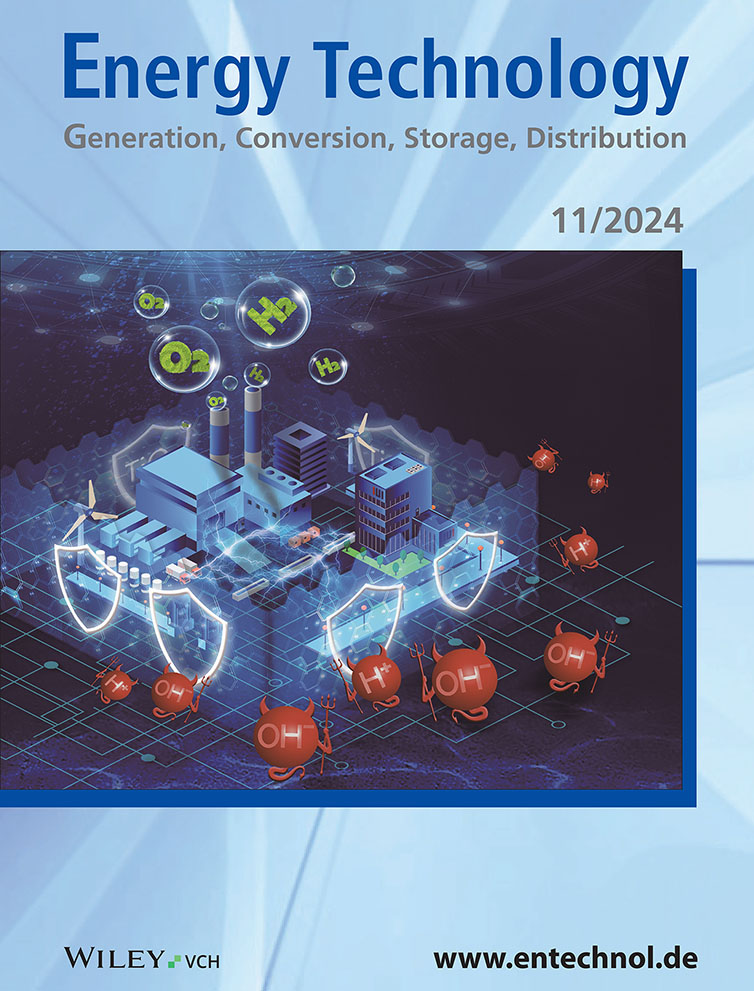基于纳米流体冷却微通道集成金属泡沫/相变材料复合材料的锂离子电池组设计
IF 3.6
4区 工程技术
Q3 ENERGY & FUELS
引用次数: 0
摘要
最近,锂离子电池出现了混合冷却技术,适当的电池组设计对于安全运行至关重要。因此,本研究探索了一种新方法,即在圆柱形电池的相变材料(PCM)+ 铝泡沫组件中使用波浪形微通道。研究比较了采用 MXene + Al2O3/ 水混合纳米流体的主动冷却(铝块中的微通道)和混合冷却(PCM 块中的微通道和泡沫-PCM 块),随后研究了微通道数量和泡沫孔隙率对冷却效果的影响。研究结果表明,在孔隙率为 85% 和孔密度为 50 PPI 的情况下,在 3C 放电条件下,7 个微通道的泡沫-PCM 产生的温度和开氏度(分别为 309.86 和 2.55 K)明显较低。与其他考虑过的区块相比,这也显示出更好的温度分布。随着孔隙率从 75% 增加到 95%,对电池和电池内部产生了不利影响,温度分别从 309.75 K 上升到 310.24 K,从 2.16 K 上升到 3.62 K。随着微通道从 3 个增加到 9 个,温度从 310.04 K 下降到 309.72 K,温度从 2.05 K 上升到 2.85 K。拟议的电池组(重量适中)具有卓越的散热性能,电池寿命的提高证明了成本的增加是合理的。本文章由计算机程序翻译,如有差异,请以英文原文为准。
Nanofluid‐Cooled Microchannel‐Integrated Metal Foam/Phase Change Material Composite‐Based Li‐Ion Battery Pack Design
Hybrid cooling has emerged recently for lithium‐ion batteries, and proper pack design is essential for safe operation. Hence, this research explores a novel approach using wavy microchannels in phase change material (PCM) + aluminum foam packs for cylindrical batteries. A comparison between active cooling (microchannels in aluminum block) and hybrid cooling (microchannels in PCM block and foam‐PCM block) employing MXene + Al2 O3 /water hybrid nanofluid is made, followed by the impact of the number of microchannels and foam porosity on the cooling effectiveness. Findings indicate that the foam‐PCM yields significantly lower and (309.86 and 2.55 K, respectively) with seven microchannels at 3C discharge with porosity of 85% and pore density of 50 PPI. This also shows a better temperature distribution than other considered blocks. With the increase in porosity from 75% to 95%, there is an adverse effect on and within the cells, which increases from 309.75 to 310.24 K and 2.16 to 3.62 K, respectively. With the increase in microchannels from three to nine, the decreases from 310.04 to 309.72 K, while the increases from 2.05 to 2.85 K. The proposed pack (having moderate weight) yields superior thermal performance, and the enhanced battery life can justify the increased cost.
求助全文
通过发布文献求助,成功后即可免费获取论文全文。
去求助
来源期刊

Energy technology
ENERGY & FUELS-
CiteScore
7.00
自引率
5.30%
发文量
0
审稿时长
1.3 months
期刊介绍:
Energy Technology provides a forum for researchers and engineers from all relevant disciplines concerned with the generation, conversion, storage, and distribution of energy.
This new journal shall publish articles covering all technical aspects of energy process engineering from different perspectives, e.g.,
new concepts of energy generation and conversion;
design, operation, control, and optimization of processes for energy generation (e.g., carbon capture) and conversion of energy carriers;
improvement of existing processes;
combination of single components to systems for energy generation;
design of systems for energy storage;
production processes of fuels, e.g., hydrogen, electricity, petroleum, biobased fuels;
concepts and design of devices for energy distribution.
 求助内容:
求助内容: 应助结果提醒方式:
应助结果提醒方式:


